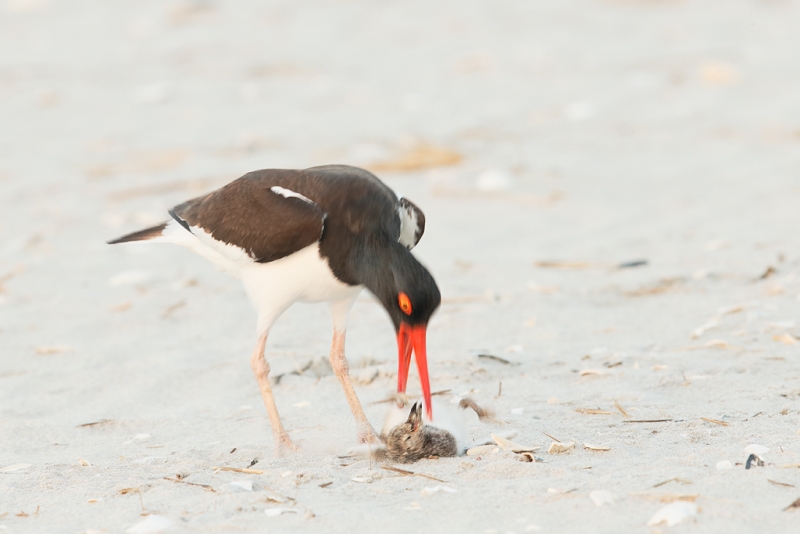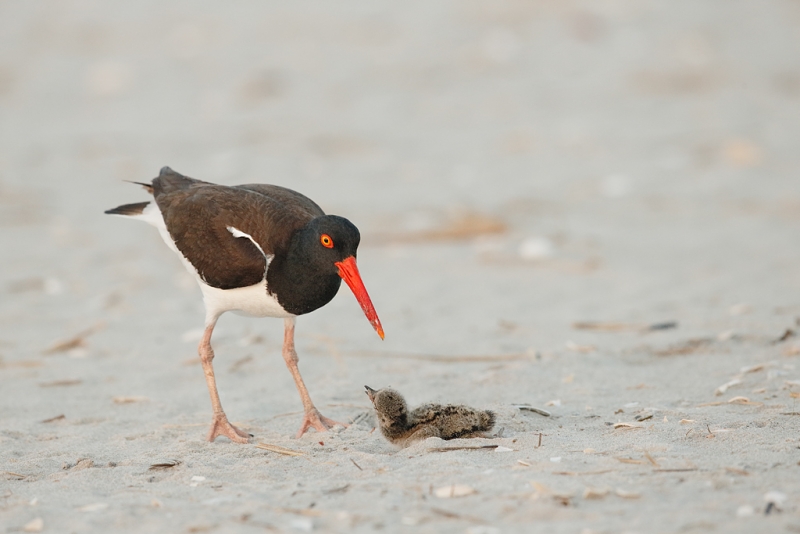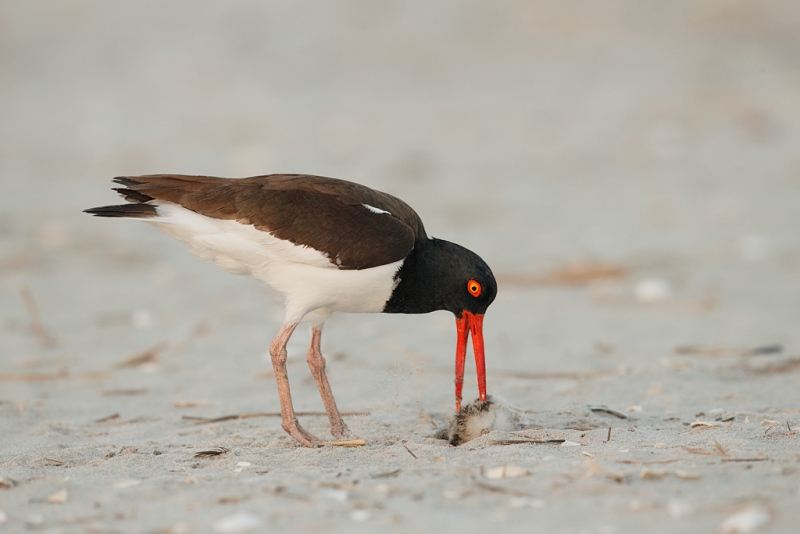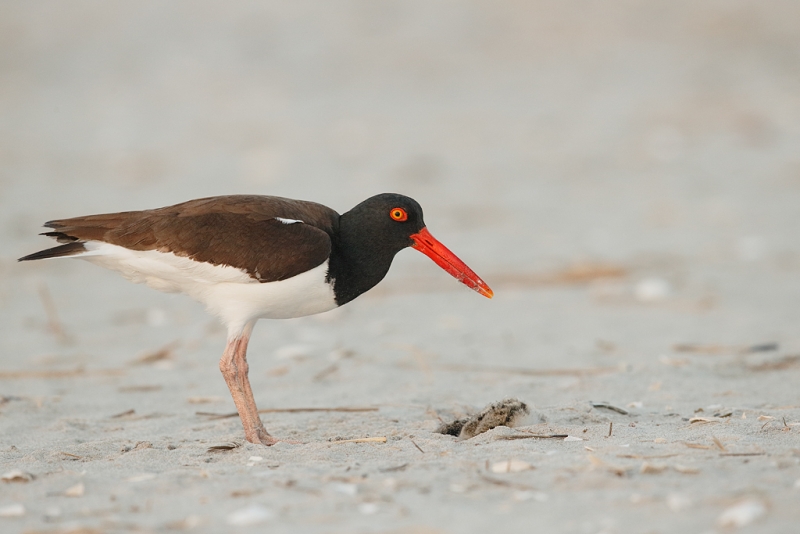|
This graphic image was created with the tripod-mounted Canon EF 600mm f/4L IS II USM lens and the Canon EOS-1D X Digital SLR camera. ISO 1600. Evaluative metering probably plus 2 1/3 stops: 1/80 sec. at f/10 in Manual Mode. Central sensor Surround/AI Servo/Rear Focus on the point just forward of the folded wing active at the moment of exposure. Click here if you missed the Rear Focus Tutorial. Click on the image to see a larger version. Time 7:53:29. |
Warning: Graphic Violence & Murder
After a wonderful afternoon of photographing oystercatchers and shorebirds at Nickerson Beach on the afternoon of Monday, May 21, I was on my way back to my vehicle when I noted an American Oystercatcher pair with a chick heading back to the protection of the roped off colony. As it was getting dark I continued on my way. In a few steps I noted a second chick that had become separated from its family. Without much concern I walked towards it herding it gently towards the colony and its parents that were not a long way off to my left. As the little guy made its way under the strings of the colony an adult oystercatcher flew in from my right, pounced on the chick, and began pummeling it with its stout bill. I followed my own advice by shooting first and asking shutter speed and exposure questions later. The image above was the 1st in the sequence.
|
This image was created with the tripod-mounted Canon EF 600mm f/4L IS II USM lens and the Canon EOS-1D X Digital SLR camera. ISO 1600. Evaluative metering probably plus 1 stop: 1/500 sec. at f/5.6 in Manual Mode. Central sensor Surround/AI Servo/Rear Focus on the adult’s neck active at the moment of exposure. Click here if you missed the Rear Focus Tutorial. Click on the image to see a larger version. Time 7:53:46. 23 seconds after the opening image was made. |
Setting a Faster Shutter Speed
I made three images of the initial assault before realizing that the images were too bright and that the shutter speed was much too slow. When I made this image I was sure that the chick was already dead. The attack was so unexpected and so violent that I was not thinking very clearly.
|
This image was created with the tripod-mounted Canon EF 600mm f/4L IS II USM lens and the Canon EOS-1D X Digital SLR camera. ISO 1600. Evaluative metering probably plus 2/3 stop: 1/640 sec. at f/5.6 in Manual Mode. BTW, I realized while preparing this blog post that I could have been working at f/4 but as I said, I was not thinking clearly at the time…. Central sensor Surround/AI Servo/Rear Focus on the top of the base of the adult’s bill active at the moment of exposure. Click here if you missed the Rear Focus Tutorial. Click on the image to see a larger version. Time 7:54:01. 25 seconds after the preceding image was created. |
Last Gasp…
Here the totally defenseless chick raised its head in feeble defense. What is not evident in these images is the fury of the pounding.
|
This image was created with the tripod-mounted Canon EF 600mm f/4L IS II USM lens and the Canon EOS-1D X Digital SLR camera. ISO 1600. Evaluative metering probably plus 2/3 stop: 1/640 sec. at f/5.6 in Manual Mode. BTW, I realized while preparing this blog post that I could have been working at f/4 but as I said, I was not thinking clearly at the time…. Central sensor Surround/AI Servo/Rear Focus on the bottom of the center of the folded wing active at the moment of exposure. Click here if you missed the Rear Focus Tutorial. Click on the image to see a larger version. Time 7:54:37. 37 seconds more have elapsed…. |
The Only Possible Outcome
I’ve lowered my tripod now and at this point it is obvious that the chick is dead.
|
This image was created with the tripod-mounted Canon EF 600mm f/4L IS II USM lens and the Canon EOS-1D X Digital SLR camera. ISO 1600. Evaluative metering probably plus 2/3 stop: 1/640 sec. at f/5.6 in Manual Mode. BTW, I realized while preparing this blog post that I could have been working at f/4 but as I said, I was not thinking clearly at the time…. Central sensor Surround/AI Servo/Rear Focus on the bottom of the center of the folded wing active at the moment of exposure. Click here if you missed the Rear Focus Tutorial. Click on the image to see a larger version. Time 7:54:41. This one was made only 4 seconds after the previous image. |
The End
The adult is now satisfied that it has killed the chick and a moment later walks off to the east. I have seen many Black Skimmer chicks killed by Great Black-backed Gulls but none of those attacks got to me as much as this one did, not only because the chick was killed by one of its own species but because of the violence of the attack.
What’s the Biology?
It is all rather simple. Oystercatchers kill the chicks of other pairs to increases the odds that its chicks will survive as there will be less competition for food resources. A bird’s sole reason for existence it to increase the chances of passing its genes along to the next generation. Adult Black Skimmers routinely attack and often kill wandering chicks from other nests but before yesterday I had not seen this behavior with oystercatchers. I am unsure as the whether I have heard of it. If anyone has online access to BONA (Birds of North America) it is likely that they can learn more to share with us here. I have a hard copy at home.
More Short Notice, Dirt Cheap, Small Group, In-the-Field Nickerson Beach Photographic Instruction with Arthur Morris. May 27 (am & pm), May 28 (am & pm) and May 29 (am only). All 2013 of course. Morning sessions: 5am sharp-9:30 am. Afternoon sessions: 4pm til whenever. These are priced so low that you need to e-mail for the rates. Limit 5/session.
If you e-mail, please include all phone numbers. Payment in full due immediately via credit card after calling the office on a weekday: 863-221-2372. If you would like to join me, please get in touch via e-mail. Breeding American Oystercatcher (chicks likely) and Piping Plover (chicks possible). Common Tern and Black Skimmer/courtship behaviors. Herring and Great Black-backed Gulls. Breeding plumage Sanderling and other shorebird species. Lots of flight photography when the wind is right. Learn digital exposure and creative image design. Learn to create pleasing blurs at 5am.
Nickerson Baby Beach-nesting Birds IPT: July 23-25, 2013: $1099. Introductory slide program: Monday, July 22, 2013. Limit 12/Openings: 1. Co-leader: Denise Ippolito.
This IPT is now a go. Conditions at Nickerson are excellent. Join Denise and me on Long Island, NY this coming summer to photograph Common Tern chicks, baby American Oystercatchers, and just-hatched Black Skimmer chicks along with the adults. The opportunities will include chances to photograph a variety of breeding behaviors including courtship feeding, display flight and combat, and copulations. Car-pooling is recommended; if we opt to return to the beach before 5pm there is a $30/vehicle parking fee that is not included so it is best to share that expense. Parking in the morning is free.
Now that the trip is a go–we had been worried about the effects of Hurricane Sandy–I fully expect that this IPT will fill almost instantly. Payment in full is due by check upon registration.
IPT Info
For complete IPT info including schedule, cancellation policies, and the registration and release forms, click here.
New York City–On Location with Denise Ippolito & Arthur Morris May 25 – 26, 2013, 2-day Workshop-$495
Join Denise Ippolito and Arthur Morris for a two-day creative workshop in the Big Apple. This exciting adventure through the streets of NYC will begin with an informal get-together at our hotel on the evening of May 24th. This will give us all a chance to get to know each other before we hit the streets in the morning for our first exciting photo shoot. We will explore China Town, Little Italy, Times Square, Rockefeller Center, Grand Central Station (tripod permit included) and much more during our two days together. The emphasis will be on street photography, seeing and capturing dynamic images, and expanding your creativity using a variety of in-camera techniques including HDR and Multiple Exposure.
Please contact me via e-mail for complete details and the itinerary.
Next Year In Holland
Despite a 100-year record cold spring with very few tulip fields in bloom this trip has been a spectacular success. The colors and variety of tulips at Keukenhof simply stun the mind and the senses. Denise and I are planning our Holland trip for next year: the Keukenhof Creative Tulip Photography IPT with a Touch of Holland. If you are a Happy Camper who is interested in joining Denise and me next spring, please shoot me an e-mail. Details will be announced soon.
We are currently fleshing out the details. The dates will be about the same, in mid April. In addition to the Keukenhof and the flower fields we will do an afternoon of windmills at Kinderdijk, a day in Amsterdam including a morning at the Rijks Museum and an afternoon visit to the Ann Frank House plus some street photography. We will do some street photography and fine dining in the little town of Edam. There will be about 7-9 days of photography in all. Those will include an afternoon option for a day or two of Purple Herons for those with long lenses.
Note: not surprisingly, early interest has been huge with several folks who want to sign up right now. The formal announcement of the dates and price is imminent.
Typos
On all blog posts, feel free to e-mail or leave a comment regarding any typos, wrong words, misspellings, omissions, or grammatical errors. Just be right. 🙂
Support the BAA Blog. Support the BAA Bulletins: Shop B&H here!
We want and need to keep providing you with the latest free information, photography and Photoshop lessons, and all manner of related information. Show your appreciation by making your purchases immediately after clicking on any of our B&H or Amazon Affiliate links in this blog post. Remember, B&H ain’t just photography!




Support the Blog


Amazon
Everyone buys something from Amazon, be it a big lens or deodorant. Support the blog by starting your search by typing in the little white box below. No purchase is too small to be appreciated; they all add up. Why make it a habit? Because I make it a habit of bringing you new images and information on an almost daily basis.
And from the BAA On-line Store:
LensCoats. I have a LensCoat on each of my big lenses to protect them from nicks and thus increase their re-sales value. All my big lens LensCoat stuff is in Hardwood Snow pattern.
LegCoat Tripod Leg Covers. I have four tripods active and each has a Hardwood Snow LegCoat on it to help prevent further damage to my tender shoulders 🙂 And you will love them in mega-cold weather….
Gitzo GT3532 LS CF Tripod. This one replaces the GT3530LS Tripod and will last you a lifetime. Learn more about this great tripod here.
Mongoose M3.6 Tripod Head. Right now this is the best tripod head around for use with lenses that weigh less than 9 pounds. For heavier lenses, check out the Wimberley V2 head.
Double Bubble Level. You will find one in my camera’s hot shoe whenever I am not using flash.
The Lens Align Mark II. I use the Lens Align Mark II pretty much religiously to micro-adjust all of my gear an average of once a month and always before a major trip. Enjoy our free comprehensive tutorial here.
BreezeBrowser. I do not see how any digital photographer can exist without this program.
Delkin Flash Cards. I use and depend on Delkin compact Flash Cards and card readers most every day. Learn more about their great 700X and 1000X cards here or about my favorite Delkin card here.



















A sad story, but it is an unfortunate part of nature.
I agree that you should not interfere with nature.
We have had several instances of the Great Blue Heron,
plucking down whistling ducklings.
this would have been a perfect time to go video.
For sure, but my brain does not think that way….
I’ve seen a bald eagle grab a duckling off a lake. I saw that same eagle make many attempts at fish and come up empty clawed, but the cute, fluffy duckling was as the saying goes “a sitting duck”.
Hmmm… well, if nothing else, this would decrease the number of foolish oystercatchers by eliminating them young. It serves a purpose, no matter how grim. The crabs and ants will feed tonight! Still sad.
Well, THAT sure spoiled my love of Oyster Catchers! I hate facing reality.
I think Artie was in the right place at the right time to record the truth about nature survivial techniques, thanks for the great shots and insight.
Sad, indeed, to see nature’s barbaric truth. Nothing is wasted. Unfortunately, the nesting season feeds the food chain and we see some strange things. I saw a baby owl eat it’s younger brother because he was hungry [online webcam at Starr Ranch.]The mother had lost her mate and could not feed them all.
I’ve photographed 11 cute ducklings, and two hours later saw them all, one by one head to the Red Tail nest. Perfect meals for growing fledges. The shots were amazing, but it does put a damper on the satisfaction from the rare photos we are all looking for.
As the years go on, I seem to get more attached and more protective of wildlife. One thing for sure, if you think about it, there is a reason for every natural wildlife instinct that we witness.
I have to ask Artie, Do you mean (BNA) Birds of North America Online from the Cornell Lab of Onithology, which the print version was compromised of 18 volumes. I checked it out online because I was interested and see it’s an online subcriber. Would love to have those 18 volumes on my bookshelf but doesn’t appear possible. Was curious what book you have the “hard copy” of at home.
As for the Blog post, so much tragedy in nature you managed to capture well here under your own shoot now, think later advice.
Yes, BNA = BoNA. I got a hard copy as part of the deal for a good number of my images. What I have at home is a small bookcase full of the individual species accounts. I love black cases. With an index.
So sad… We just lost a young-but-not-quite-fledged dove chick off our desk a week ago. After taking pictures of the progress, it was a loss. We thought it might have been a blue jay or perhaps (not as likly) an owl. Sad loss when it happens…
Surely you could have stepped in and chased the killer away?
Why on Earth would Art do that, Anand?
Aside from the fact that this is a known, (rarely) documented survival strategy for Oystercatchers, it’s pretty much a given that wildlife photographers don’t interfere with the nature they shoot.
Or would you have Art fight off the Lions killing a Wildebeest calf too?
I get The Prime Directive and had this been a lion I would have done nothing fearing for my own safety (not to mention that the lion kills to eat). But in this case the reality is that somebody died at least partially as a result of my inaction. To each his own, but I am not sure I could have lived with that, and documenting it from 10′ away would have made it even worse.
Anand: What exactly would you have done? Offered the chick to all the adults until you found its parents? Driven the adult away and then left the chick to die anyway? Taken it home and nursed it to adulthood? Unpleasant as this would have been to watch and is to see in photos, it’s just not clear what could have been done assuming you decided it was right to do something. Or are you saying Artie shouldn’t have taken the photographs?
David, I thought I outlined what I would have done which is to chase the killer away. Does that action make cold rational sense *for the chick* – no. But it makes cold rational sense for me because otherwise I could not have lived with myself. Saving the chick is not so much compassion as it is self-interest.
Nature red in tooth and claw. Pretty quick thinking and photographing on your part! I’ve seen a crow kill a robin chick that had fallen out of its nest but I figured the crow was looking for a meal.